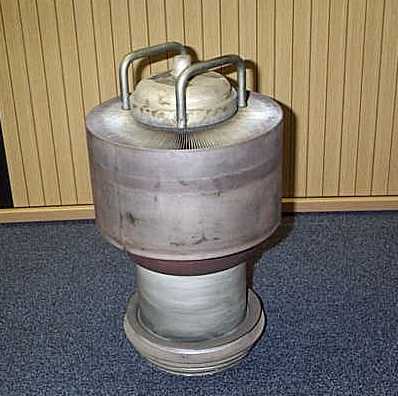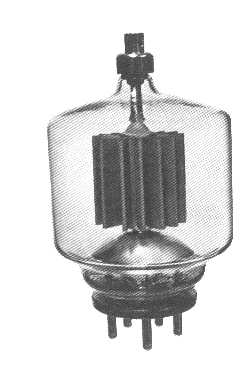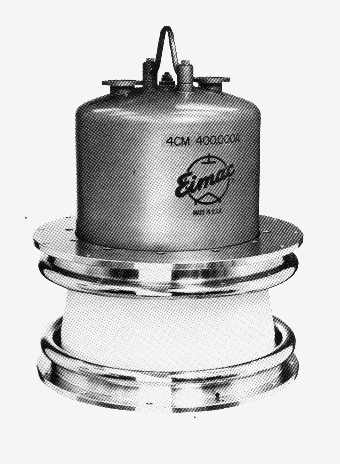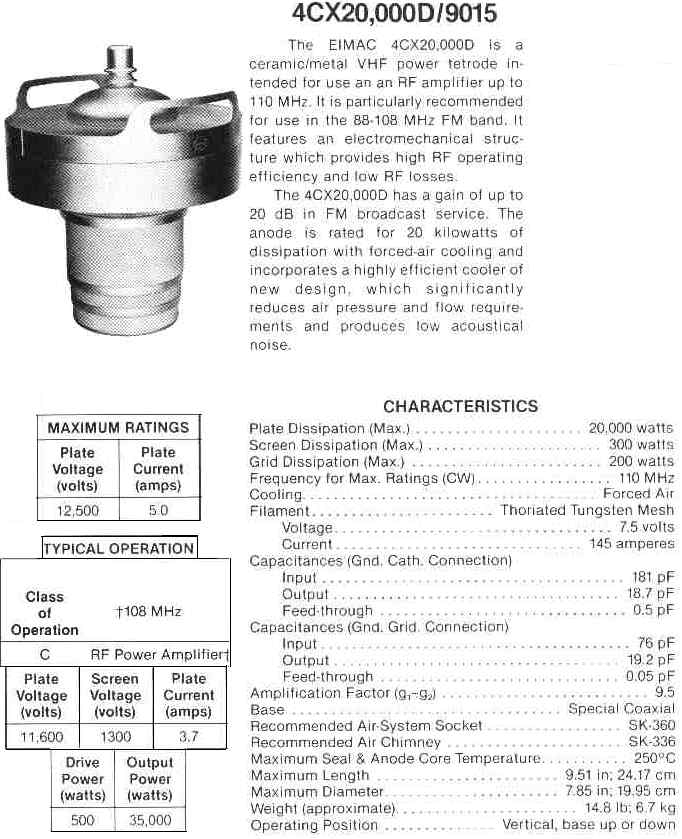NRG Workshop featuring high power electronicVacuum Tubes
The 4CX35,000 High Power HF Tetrode valve (up to 30 MHz)
 |
This is a real life 4CX35,000 high power transmitting tube that has seen some service. These valves last about 75,000 hours, cost over £6000 and have massive power gains. This type can be used at up to 30 MHz and is frequently found in medium wave and short-wave high power transmitters. It can deliver up to 55,000 watts of RF power with a drive power of around just 100 watts. Forced air cooling cooling is used. The filament alone draws 300 amps at 10 volts, that's a 3 kW heater for the cathode! The anode voltage is around 20 kV and around 5 amps is drawn at full output. These valves stand about 18 inches tall with a diameter of some 10 inches. They have to be handled very carefully as they are precision devices and are quite heavy, weighing around 50 lb (23 kg). In conventional AM transmitters, high power valves are unbeatable on linearity and their popularity continues. |
A low power tube--the 3-500Z, just 500 watts! (Up to 110MHz
 |
The 3-500Z Triode Valve This really is a baby in the transmitting tube world, a mere 500 watts output although it can be pushed to 700 watts. Unlike the big ceramic valves, this one looks more like a traditional receiving tube as the envelope is made of glass. This type of valve is often used in zero bias grounded grid configuration, the drive power is applied to the cathode. This provides very stable operation due to the grid screening the input (cathode) from the output (anode). Zero bias grounded grid makes the circuit simple as no bias circuitry is need and the linearity is good. The gain is low by tube standards though and around 40 watts of drive will be needed for full output. The tube is about 6 inches high and 3.5 inches in diameter. The operating voltage is a mere 4000 volts and the current drawn at full power output will be around 0.3 amps. The cathode heater draws 15 amps at 5 volts to provide the necessary emission from cathode to anode. |
The 4CM400,000A Very High Power Tube (1MW at up to 110MHz)
 |
Water-Vapour cooled power Tetrode Valve This is probably as powerful as tubes get. This device can deliver just over 1 million watts of RF power at frequencies up to over 100 MHz in class C FM service. For AM linear service the max. carrier power would be about 500 kW. At this power output level, the cooling system is done with steam and there is about 300 kW of heat to dissipate. The maximum allowable dissipation is 400,000 watts of heat continuously. The cathode heater draws 600 amps at 16 volts, the Anode voltage is around 22 kV and the anode current is around 60 amps. About 3 kW of drive is needed at HF frequencies to deliver 1 million watts output. Although rated for broadcasting service up to VHF frequencies, this very high power level is better suited to Short-wave broadcasting and the valve is used mainly for this purpose. Whilst these things are only 18 inches high and 17 inches wide, they are very heavy and weigh around 170 lb. |
The 4CX20,000 High Power VHF Tetrode valve (up to 110 MHz)
If you are thinking of upgrading your private
radio station then you may want to consider the
device below. In the world of very high transmitter power, the valve
remains the most
economical device to use. They are also the most dangerous things
to be playing around
with. The 4CX20,000 is a high power VHF Tetrode valve with a power
gain of around 20dB, 100
times in other words. At full power, the gain will drop a little.
As the specs show, 500
watts at the grid will be amplified to 35,000 watts at the anode.
There will be at least
10,000 watts of heat generated by the valve, and this heat would be
used to heat the offices
and working areas in the building. These valves operate with a supply
voltage of 12000 volts
DC at substantial amperage, so obviously no one can go near the valve
whilst it is powered
up. The power at the anode is applied to a tuned cavity which can
match the high valve output
impedance to the nominal 50 ohms. The table at the bottom shows the
performance of the valve
in class C service, at a frequency of 108MHz.
